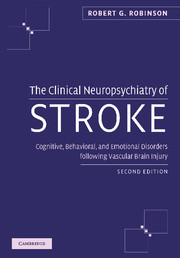 The Clinical Neuropsychiatry of Stroke
The Clinical Neuropsychiatry of Stroke Book contents
- Frontmatter
- Contents
- Preface
- Part I Introduction
- Part II Poststroke depression
- Part III Poststroke mania
- Part IV Poststroke anxiety disorders
- Part V Other poststroke disorders
- 34 Psychosis
- 35 Anosognosia and denial of illness
- 36 Catastrophic reaction
- 37 Apathy
- 38 Disturbance of prosody
- 39 Irritability and aggression
- 40 Pathological laughing and crying
- 41 Summary and future directions
- Index
40 - Pathological laughing and crying
from Part V - Other poststroke disorders
Published online by Cambridge University Press: 01 October 2009
- Frontmatter
- Contents
- Preface
- Part I Introduction
- Part II Poststroke depression
- Part III Poststroke mania
- Part IV Poststroke anxiety disorders
- Part V Other poststroke disorders
- 34 Psychosis
- 35 Anosognosia and denial of illness
- 36 Catastrophic reaction
- 37 Apathy
- 38 Disturbance of prosody
- 39 Irritability and aggression
- 40 Pathological laughing and crying
- 41 Summary and future directions
- Index
Summary
The association of brain injury with uncontrollable episodes of crying, or less frequently laughing, has been recognized as a consequence of brain injury since the 19th century (Wilson 1923; Davison and Kelman 1939). In 1877, Lépine described pseudobulbar palsy as a cranial nerve palsy (i.e., inability to swallow, move the tongue, articulate, forcefully close the eyes) induced by supranuclear lesions (i.e., lesions of the corticobulbar or corticopontine pathway) resulting from bilateral strokes. A frequent accompaniment of pseudobulbar palsy was uncontrollable crying or laughing which was referred to as pseudobulbar affect. Patients would present with an incongruity between the loss of voluntary facial movement and the unimpaired reflexive facial movements associated with spontaneous laughing or crying. Most cases of uncontrollable crying and laughing, however, were not associated with bilateral upper motor neuron or supra tentorial motor pathway lesions. Therefore, most clinicians abandoned the term, pseudobulbar affect, in favor of the more general term, pathological laughing and crying (Davison and Kelman 1939).
Pathological laughing and crying is a phenomenon characterized by outbursts of emotion which are out of proportion to the underlying feelings of happiness and sadness (Wilson 1923). The clinical manifestations of pathological emotions may range from facial expressions of happiness or sadness to loud and uncontrolled outbursts of laughing or weeping.
- Type
- Chapter
- Information
- The Clinical Neuropsychiatry of StrokeCognitive, Behavioral and Emotional Disorders following Vascular Brain Injury, pp. 429 - 446Publisher: Cambridge University PressPrint publication year: 2006


